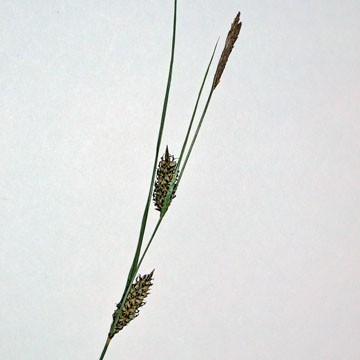

Carex lasiocarpa - (image 1 of 5)
Taxonomy
Family: Cyperaceae
Section Paludosae
Habitat
Wet meadows, fens, shores.
Associates
Distribution
Circumboreal; North American plants with slightly smaller perigynia and shorter beak teeth have been calls ssp. americana.
Morphology
Perennial to 1 m, forming vigorous colonies from creeping rhizomes; leaves glabrous or scabrous, permanently folded along the midrib and tending to appear subterete, only 1-1.5(-2) mm wide as folded; terminal spikelet staminate, 2-5 cm, often subtended by one or two shorter, sessile staminate spikes; pistillate spikes two or three, 1-4 cm, sessile or the lowest one on an erect, slender peduncle; leafy bracts present, the lowest elongate, often surpassing the terminal spikes; perigynia pubescent, 2.8-4.3 mm long; stigmas 3; achenes trigonous.
Notes
Fruiting June to August
Wetland indicator: OBL
Similar to C. pellita except for the folded leaves (those of C. pellita are essentially flat). Often dominant in wet calcareous sedge meadows and easily recognized by the wispy filiform leaf tips of the vegetative shoots.
References
Gleason, Henry A. and A. Cronquist. 1991. Manual of Vascular Plants of
Northeastern United States and Adjacent Canada. Second Ed.
The New York Botanical Garden. Bronx, NY
|
© Michael Hough 2018 |